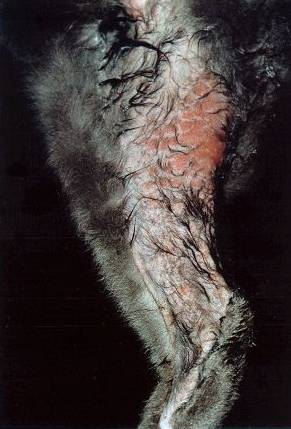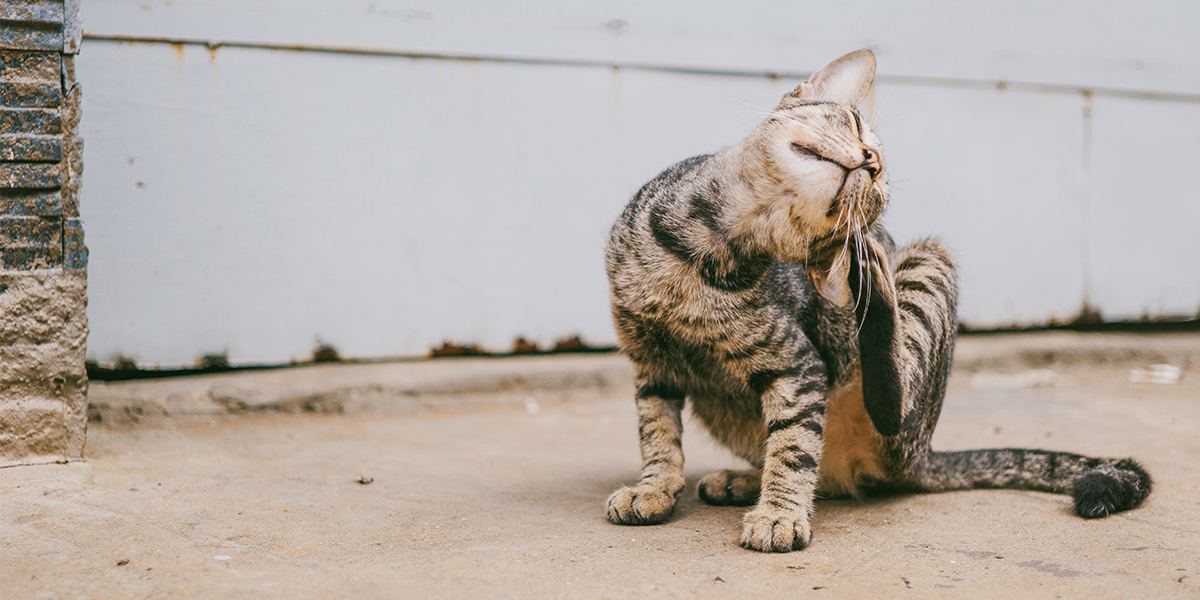Fleas remain the most common cause of skin disease in cats, although this is not true in all countries (in some regions fleas are rare), and fleas are not the only cause of pruritus (itchy skin) in cats. Where fleas are not the answer, often a much more detailed and meticulous approach is needed to find the diagnosis.
In some instances in cats, it can be very difficult to differentiate between skin disease due to pruritus and skin disease induced by other causes. For example, in humans and dogs, hair loss is almost always hormonal in origin. However, in cats, hormonal skin disease is so rare as to be virtually non-existent. Hair loss in cats is actually almost always caused by excessive self-grooming due to pruritus — but cats may be ‘secret groomers’ and often we may be unaware that the cat is grooming more frequently or more aggressively.

Severe pruritus and eosinophilic
plaques associated with flea allergy – note matting of the fur with saliva
Manifestations of feline pruritus
Common manifestations of pruritic skin disease in cats include:
- Overt itching, scratching and self-induced skin damage
- Symmetrical hair loss
- ‘Miliary’ dermatitis – this form of skin disease is characterised by the presence of tiny 2-3 mm diameter crusts throughout the body surface. The skin and coat may also be greasy and have excessive dandruff
- Eosinophilic granuloma complex – see eosinophilic granuloma complex in cats – this is a variety of skin lesions (indolent ulcer that affects the upper lip, and eosinophilic plagues or eosinophilic granulomas that can affect various areas of the body and also the oral cavity. They are usually associated with allergies. All of these manifestations of pruritus look completely different, but can all be caused by the same things — in most instances the cause is fleas but other parasites and allergies can be involved. Some cats may have more than one manifestation of disease present simultaneously eg, indolent ulcer and symmetrical hair loss.
What can cause cats to itch other than fleas?
Important causes of pruritus other than fleas include:
- Food intolerance/allergy
- Atopy (house dust and pollen allergy)
- Insect bites
- Ear mites and other mites
- Bacterial infections
Food intolerance or allergy
No-one knows the exact mechanisms by which certain foods can make animals and humans itch. Allergy may be involved, but in some cases, it is possible that the pruritus may result from chemical reactions to the food or to additives and preservatives.
However, it is well recognised that changing the diet to a food that cats have not previously been exposed to can cure some cases of pruritic skin disease. Most of these are probably food allergies but the terms ‘food intolerance’ or ‘food-responsive’ skin disease are sometimes used as a specific diagnosis is often not made.
Cats may need to be fed an alternative diet for a period of 6-8 weeks to rule out food-response dermatitis, and the choice of food is important. This is not simply switching one brand of cat food for another, as the ingredients are often very similar. Your vet will advise you on the most appropriate diet to use – this might be a home-prepared diet, or your vet may suggest a special ‘hypoallergenic’ diet for the trial period. Many cats also hunt or may be fed by neighbours, which can complicate the trial as it is important that no other foods are eaten during the trial period.
Atopy (atopic dermatitis; dust and pollen allergy)
Atopy is not well characterised in cats. In humans and dogs, the term is strictly used to describe an inherited predisposition to develop allergic reactions to environmental allergens (such as pollen and house dust). Allergies to pollen and house dust occur in cats, and may be a potential cause of pruritus, but they are difficult to diagnose and it is unknown whether there is an inherited component to the disease.
In most cats, atopy is diagnosed by ruling out other potential causes of pruritus, including fleas and other parasites, and food. Allergy testing can be performed on cats (for example intra-derma skin tests) but the results are rather unreliable. Blood tests are also offered by some laboratories to ‘diagnose’ atopy and the underlying cause of the allergy, but these are less reliable than skin tests, and both false positive and false negative tests are well recognised.
Atopy is incurable and life-long medication is needed to prevent unacceptable discomfort. Treatment with essential fatty acids and anti-histamines is successful in only a minority of cases. Many cats need long-term corticosteroids or other immunosuppressive drugs such as cyclosporin. If an allergy test has successfully identified the offending allergen, then it is possible to use a ‘hyposensitisation vaccine’ as a therapy – these rarely resolve the disease but in some cases reduce the need for drug therapy.
Insect bites
Insects such as wasps and bees can cause stings that lead to dramatic, painful and swollen skin. However, some other insects including fleas, midges, flies and mosquitoes may bite and the reaction to the bite (or the insect saliva) may cause intense irritation and pruritus. Flying insects usually bite relatively hairless areas such as the bridge of the nose and ears. Notably, mosquitoes have been reported to cause an eosinophilic granuloma-like reaction on the bridge of the nose of some cats (mosquito-bite hypersensitivity).
Ear mites – Otodectes cynotis
Ear mites are well known as the major cause of otitis externa (ear inflammation) in young cats and in breeding colonies – see common ear problems in cats. However, it is also possible for the mites to wander onto the skin around the head and neck and cause pruritic skin disease at these sites. As cats sleep curled up, spread of infection (and subsequent dermatitis) to the rump and tail may also occur.
Other mites
Harvest mites are a recognised cause of skin disease in cats in some areas in late summer and autumn – see harvest mite infection in cats. These tiny orange dot sized mites are visible to the naked eye and usually found between the toes and in Henry’s pocket of the ear flap.
In some parts of the world, the mites Noedres cati and Sarcoptes scabiei may be found on cats and may be a cause of intense pruritus.
Bacterial skin infections (pyoderma) and fungal (yeast) infections
Although bacterial skin disease in cats is uncommon, it may occur and there are occasional cases of spectacular recovery following antibiotic treatment in pruritic cats. This is unusual, but more work is needed in this area.
Dermatophytosis (infection with a dermatophyte fungal organism) is not usually pruritic, but skin infection with yeasts (Malassezia) can be a problem in some cats – this is often secondary to allergic skin disease, but the yeasts may also contribute to the pruritus.
Thank you for visiting our website, we hope you have found our information useful.
All our advice is freely accessible to everyone, wherever you are in the world. However, as a charity, we need your support to enable us to keep delivering high quality and up to date information for everyone. Please consider making a contribution, big or small, to keep our content free, accurate and relevant.
Support International Cat Care from as little £3
Thank you.
Donate Now


